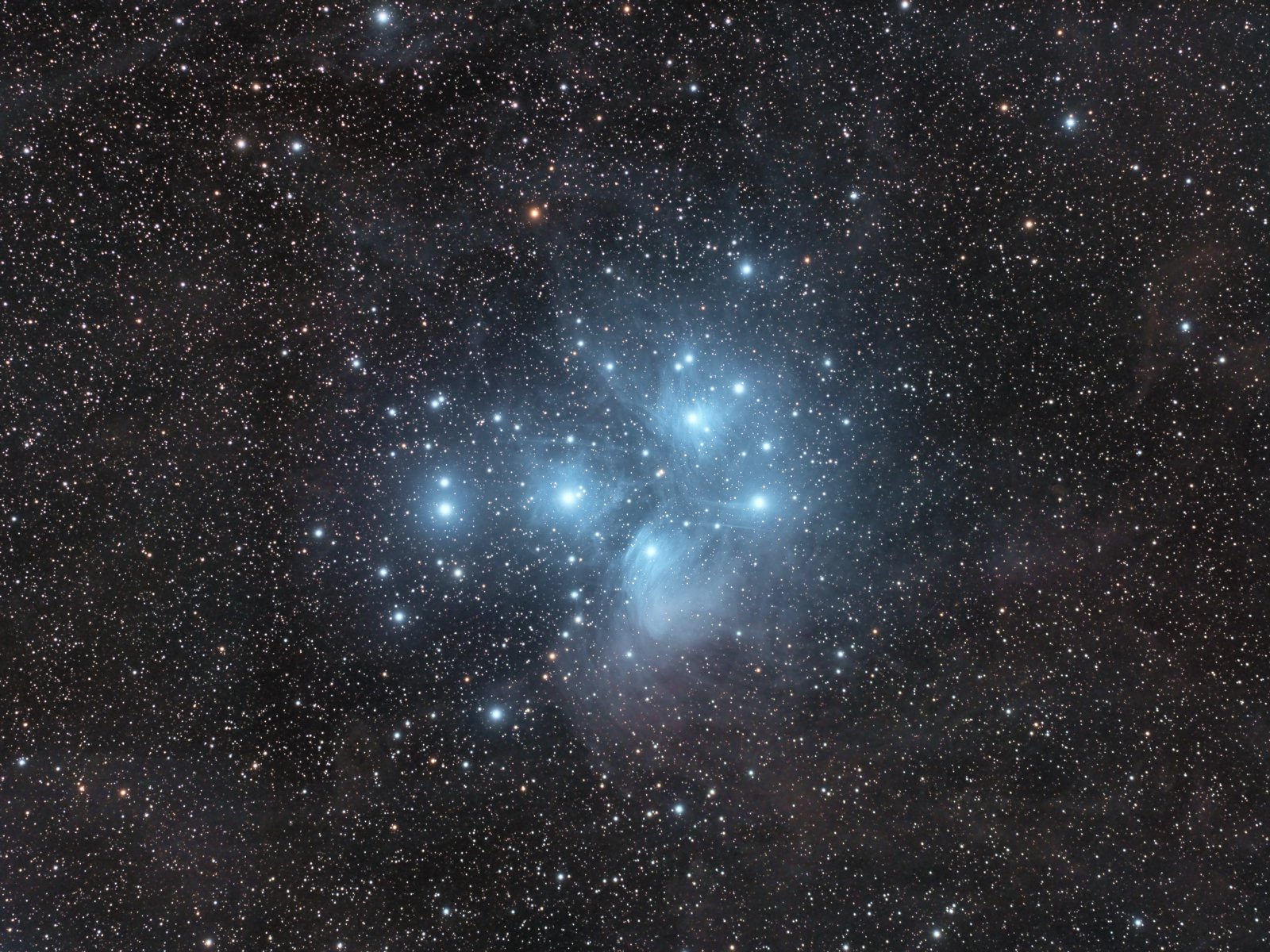M45 (2020)
 Click image for full size version
Click image for full size version
March 21, 2020
M45 is better known as the Pleiades, or the Seven Sisters. In Latin America, it’s called “the Seven Kids”, referring to baby goats. It is one of the objects that I image with every setup, because it is bright, beautiful, and a real challenge to process.
The Pleiades was observed and written about long before Messier catalogued it. Galileo published a sketch in 1610 that showed 36 stars that he could see with his telescope. The earliest known depiction of the Pleiades is from is about 17,000 years old: a cave drawing in the Lascaux Cave in France. If you get a chance, have a look at this object through binoculars. It is spectacular and well placed for imaging this time of year.
The blue haze around this star cluster is a reflection nebula – star light is being reflected of soot/dust particles in the background. There’s also some pinkish emission nebula (NGC 1435) in the lower portion of the nebula and dim brownish dust mottling the outer parts of this field (called “cirrus”). M45 is about 440 light years from us and contains at least 1000 members in the cluster. The stars have been estimated to be between 75 and 150 million years old. The brightest cluster stars belong to class B, and are very hot bluish stars.
Although the star cluster and reflection nebula are the dominant objects in this shot, there are also hundreds of galaxies lying far in the background. I have posted an annotated image from 2017 that highlights the location of some of them. In October 2016 I posted a higher resolution image that shows even more galaxies.
Tekkies:
Takahashi FSQ-106 ED IV @ f/3.6, QHY367C one-shot colour camera, and Optolong L-Pro filter, Paramount MX, unguided. Acquisition, and focusing with TheSkyX. Focus with Optec DirectSync motor and controller. Automation with CCDCommander. Equipment control with PrimaLuce Labs Eagle 3 Pro computer. All pre-processing and processing in PixInsight. Acquired from my SkyShed in Guelph. Half-moon, average transparency and poor seeing. Data acquired January 21-February 21, 2020.
70x10m with Optolong L-Pro filter (Total = 11hr40m)
Image scale 2.6 arcsec per pixel
Data Reduction and Cleanup
Preprocessing: The WeightedBatchPreProcessing script was used to perform calibration, debayering, weighting, and registration of all frames. ImageIntegration followed by DrizzleIntegration with the CFA Drizzle option was used to make the master, which was then cropped.
Gradient Removal: DBE was applied using Subtraction to remove the minimal gradient that remained after integration.
Channel Registration: To improve channel registration, the RGB colour channels were extracted and aligned with StarAlignment, using Thin Plate Splines with Distortion Correction and the green channel as the reference frame. The registered colour channels were recombined with ChannelCombination.
Lightness Extraction: RGBWorkingSpace was applied to normalize the channels, and the Lightness was extracted for separate processing as described below.
Colour
Colour Balancing: The colour image was colour balanced with PhotometricColorCalibration.
Linear Noise Reduction: MultiscaleLinearTransform was used to reduce noise using an internal mask to protect bright structures, along with an external star mask to protect small stars. Layer settings for threshold and strength: Layer 1: 5.0 0.85 Layer 2: 4.0, 0.75 Layer 3: 3.0, 0.5 Layer 4: 1.0, 0.25.
Stretching: HistogramTransformation was applied to make a pleasing, bright image, with background set to an intensity of approximately 0.12.
Lightness
Deconvolution: StarMask was applied with default settings to produce a Local Deringing Support Image. A clone of the image was stretched to use as a deconvolution mask. Deconvolution was applied (80 iterations, regularized Richardson-Lucy, external PSF made using PSFImage script with 26 stars).
Linear Noise Reduction: MultiscaleLinearTransform was used to reduce noise in the background areas, using an internal mask to protect bright structures. Layer settings for threshold and strength: Layer 1: 3.0, 0.9 Layer 2: 2.0, 0.75 Layer 3: 1.0, 0.6 Layer 4: 0.5, 0.2.
Stretching: HistogramTransformation was applied to make a pleasing, bright image, with background set to an intensity of approximately 0.12.
Combining Lightness and Colour Images
LRGB Combination: The lightness image was applied to the RGB image using LRGBCombination with default settings.
Additional Processing
Nonlinear Noise Reduction: TGVDenoise was used in L*a*b* mode to reduce noise with a mask used to target the background areas and protect the stars (max. 1000 iterations and convergence selected for both lightness and chrominance).
Contrast Enhancement: LocalHistogramEqualization was applied twice (scale of 54 with strength 1.0; then scale of 150 with strength 0.5) using a mask to protect stars and low-signal regions of the image. The mask was a stretched version of the Lightness image.
Sharpening: MultiscaleLinearTransform was applied twice (scale of 64 with strength 05; then scale of 200 with strength 0.3) using a mask to protect stars and low-signal regions of the image. The mask was a stretched version of the Lightness image.
Final Steps: Background, nebula and star brightness, contrast, colour saturation were adjusted in several iterations using CurvesTransformation with masks as required. A final pass of ACDNR was applied to reduce colour noise in the faint areas of the nebula and background.
The imaged was downsampled x2 using IntegerResample, restoring its native resolution of 2.6″/pixel. ICCProfileTransformation (sRGB IEC61966-2.1; Relative Colorimetric with black point compensation) was applied prior to saving as a jpg.






Very nice job on the dust, great presentation of the Pleiades.